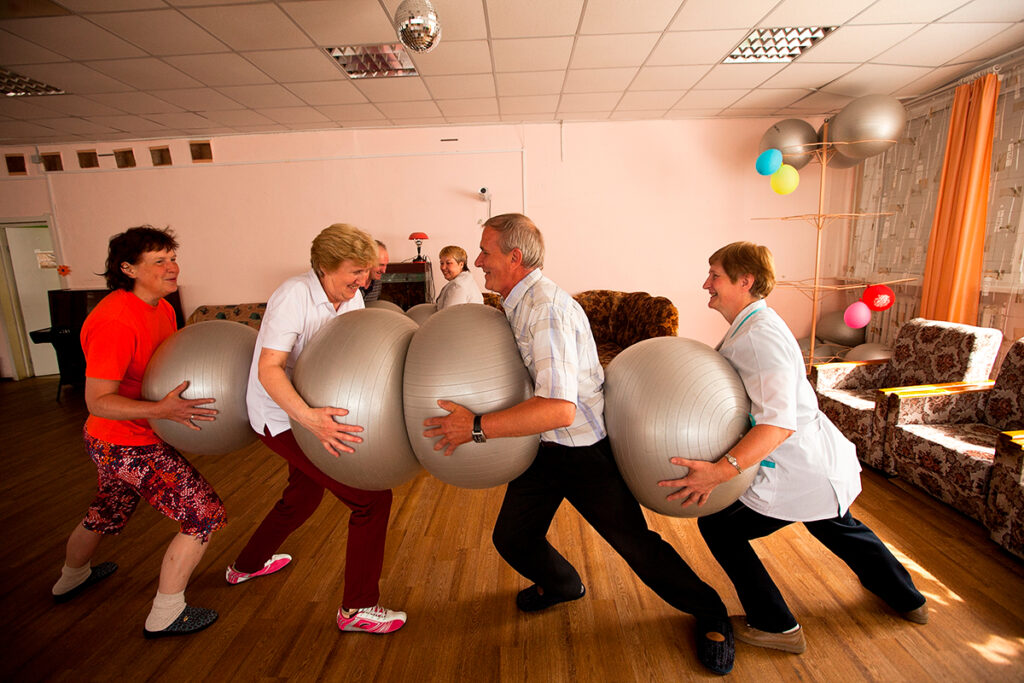7 hours is the optimal amount of sleep for people over 18. More or less sleep is associated with a shorter lifespan.
Sleep is essential for normal metabolism and tissue repair. Sleep deprivation impairs skeletal muscle nutrition and recovery, and acute sleep deprivation can lead to muscle atrophy.
Aging is associated with a decrease in total sleep time and quality and a reduction in the duration of deep sleep. Sleep disturbances are associated with age-related decline in muscle mass.
In the elderly, sleep disorders such as insomnia, sleep movement disorders, obstructive sleep apnea syndrome, and sleep-wake rhythm disorder are often observed. These disorders can lead to a chronic lack of sleep, which reduces muscle function.
Aging and lack of sleep are directly linked to increased inflammation. An increase in inflammatory markers is commonly seen in sleep disorders and conditions of reduced muscle function, such as sarcopenia.
Sarcopenia is an aging-associated muscle disease characterized by decreased muscle strength and performance and reduced muscle mass. Sarcopenia impairs the ability to perform daily tasks, increases the risk of falls and fractures, and is associated with heart and respiratory disease and cognitive impairment.
With muscle wasting, pro-inflammatory cytokines increase, enhancing the body’s breakdown processes. Pro-inflammatory cytokines can suppress protein synthesis in skeletal muscle, damaging muscle integrity, impairing muscle function, and leading to sarcopenia.
Anti-inflammatory cytokines may protect against sarcopenia. Increasing the production of anti-inflammatory cytokines can counteract the expression and activity of pro-inflammatory cytokines, reducing muscle wasting and slowing the progression of sarcopenia.
Resistance exercise can improve muscle strength and function, reduce inflammation, and improve sleep quality. A 2018 meta-analysis found that resistance training that includes at least eight muscle groups performed more than 3 times a week for 12 weeks can reduce inflammatory markers such as IL-6 and TNF-α. An animal study has shown that resistance training reduces the harmful effects of sleep deprivation on skeletal muscle.
The common thread that links sarcopenia and decreasing sleep quality is increased inflammation, which is often seen with aging. Brazilian scientists investigated how resistance training affects sleep quality and inflammation levels in older people with sarcopenia.
Study Participants
The study involved 28 older people diagnosed with sarcopenia. Participants are 65 years of age or older. None of the participants smoked or used alcohol or drugs frequently. No participant suffered from drug-uncontrolled hypertension, diabetes, hypercholesterolemia, or heart failure. None of the participants completed a physical fitness program in the past year.
Participants underwent polysomnography and blood tests for anabolic hormones and pro- and anti-inflammatory cytokines. The surveys were conducted 24 hours before the start of the study and 24 hours after its completion.
Participants were divided into two groups of 14 people:
- Control Group (CTL) – weekly meetings with recommendations for lifestyle changes.
- Resistance exercise training (RET).
Most participants had increased sleep latency – the time it takes to fall asleep: CTL – 21.6 ± 15.7 min, RET – 25.9 ± 20.2 min. The duration of light sleep was also increased: CTL – 10.3 ± 4.4%, RET – 20.6 ± 15.8%.
Both groups showed moderate sleep apnea. Apnea-hypopnea index (average number of sleep apnea and hypopnea per hour): CTL – 15.20 ± 4.37, RET – 14.08 ± 15.59.
Before the start of the study, the RET group showed an increased insomnia severity index: 8.71 ± 4.37.
Hormonal and inflammatory markers: Participants showed adequate levels of testosterone, growth hormone, and cortisol, reduced levels of insulin-like growth factor (IGF-1), and elevated levels of the cytokines IL-6 and IL-10.
Resistance Exercise Training
For 12 weeks, participants in the RET group performed weight-bearing exercises for eight muscle groups, alternating upper and lower limbs:
- chest press;
- leg press;
- vertical traction;
- abdominal crunch;
- leg extension;
- arm curl;
- leg curl;
- arm extension.
Training took place 3 times a week. Participants completed 1 set of 12-15 reps in the first week at 50% of their 1RM. In the second week – 2 sets of 10-12 reps at 60% of 1RM. From the third week to the end of the study – 3 sets of 8 reps at 75% of 1RM. Rest between sets – 60-90 seconds.
Research Results
Sarcopenia
In the RET group, hand grip strength increased: 8.95 kg compared to 0.91 kg in the CTL group. The RET group also had a 13% increase in skeletal muscle strength, measured by leg flexion and extension on a dynamometer. The CTL group is unchanged.
Sleep Quality
In the RET group, the time needed to fall asleep decreased: 16.09 ± 15.21 min compared to 29.98 ± 16.09 min in the CTL group. The difference compared to the data before the study: the RET group reduced the time to fall asleep by 5.25 minutes, and the CTL group increased it by 6.25 minutes.
In the RET group, the duration of deep sleep increased by 0.7%, while in the CTL group, it decreased by 4.9%.
In the RET group, the number of apneas per hour decreased by 2 times: 16.82 ± 14.11 before the study versus 7.37 ± 7.55 after the survey. The CTL group is unchanged.
In the RET group, insomnia severity decreased: 8.71 ± 4.37 before the study versus 5.14 ± 3.73 after the survey. The CTL group is unchanged.
Subjective sleep efficiency (Epworth Sleepiness Scale) also improved after 12 weeks in the RET group compared to baseline: 83.57 ± 14.56 versus 75.57 ± 15.37. Difference: RET group – 9.50 points, CTL – 0 points.
Hormonal, Metabolic, and Inflammatory Markers
Men in the RET group had decreased TNF-α levels. In the RET group, the levels of IL-10 and IL-1ra increased (only in men). The CTL group is unchanged.
Findings
Sleep disturbances and increased levels of inflammation in the elderly contribute to the development of sarcopenia.
12 weeks of resistance training 3 times a week increased muscle strength and improved sleep quality in older people with sarcopenia. Exercise reduced the time it took to fall asleep, increased the duration of deep sleep, and improved the subjective perception of sleep.
Lack of sleep increases the production of inflammatory cytokines. The pro-inflammatory cytokine IL-1 is associated with poor sleep, increased sleep latency, daytime sleepiness, fatigue, and obstructive sleep apnea. In addition, IL-1 is associated with circadian rhythm disturbance and muscle wasting.
Resistance exercise exerted an anti-inflammatory effect by increasing levels of the anti-inflammatory cytokine IL-10 and the protein IL1-ra, which blocks the action of the pro-inflammatory cytokine IL-1. Anti-inflammatory cytokines improve muscle nutrition and slow the progression of sarcopenia.
Although no increase in anabolic hormone levels or decrease in catabolic hormone levels has been observed, muscle hypertrophy and increased muscle strength can occur regardless of hormone levels. Muscle contractions increase muscle integrity, improve signaling for muscle fiber accumulation, and increase muscle strength.
Regular resistance training can help reduce inflammatory status by improving cell repair and sleep quality by stimulating muscle nutrition and slowing down the development of sarcopenia.
Useful article, necessary information? Share it!
Someone will also find it useful and necessary:



